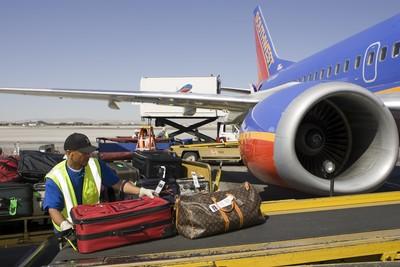Flying to LV a breeze

If it seems as if more tourists are blowing into Las Vegas it’s because they are — literally.
Number crunchers at Southwest Airlines are taking advantage of soft summer breezes to fly more passengers in and out of McCarran International Airport.
The airline uses sophisticated software to consolidate and distribute time saved when the westerly jet stream winds shift north toward the arctic and shorten flight durations, especially on longer trips between the East Coast and Las Vegas.
The result is expected to be fewer delays at McCarran and other airports, more flights in and out of Southern Nevada and the opportunity for the airline to add enough trips to fill four Boeing 737s without buying new planes at a cost of about $46 million each, at least until winter wind patterns return to slow traffic during cold months.
"It is kind of a Mother Nature type of thing. In the summer it takes less time to fly the exact same schedule than in the winter time," said Lonny Hurwitz, the airline’s network schedules manager. "As the (flight) time shrunk, we were able to collect all that time in 10 and 15 minute chunks and aggregate it."
Collecting time in busy airports makes it easier for Southwest to use it as a buffer against unexpected operational hiccups that would otherwise mushroom into longer delays.
It can also be consolidated and leveraged into additional revenue time in the air in the form of extra routes that make money for the airline and increase flight options for passengers.
The time savings have already produced additional round- trip routes between Las Vegas and Sacramento, Calif.; San Jose, Calif.; and Albuquerque, N.M.; and an extra eight hours and 45 minutes in recovery time on the ground at McCarran every day from March through October.
Airlines have long known summer weather patterns can make flights go quicker. A flight from Baltimore to Las Vegas, for example, takes about 5 hours and 30 minutes in the dead of winter but clocks in 20 minutes shorter during August, according to Southwest.
In short, the upper atmosphere wind pattern called the jet stream shifts northward during the summer and with it goes strong headwinds that prolong east-to-west flights.
What’s different this year is Southwest used in-house scheduling software to quantify the time saved and consolidated it at busy airports by shifting the way it moves its 737s — a fleet totaling nearly 500 — through a network that accommodates 3,300 flights daily, including 462 to and from McCarran, Southwest’s busiest airport.
The scheduling software has been in use for years, but Southwest hadn’t used it to quantify the difference between summer and winter flight times and redistribute it, said Hurwitz.
"For years and years, we have been doing it by hand," said Hurwitz, describing stacks of paper listing thousands of flights with billions of potential combinations. "Human beings can’t dig through all the combinations."
Nationally, the extra time totals 50 hours of revenue flying and 30 hours for on-the-ground recovery every day, Hurwitz stated.
The time and money are important because Southwest — despite its reputation as one of America’s most functional airlines — faces challenges similar to lumbering "legacy carriers" that make headlines for bankruptcy filings and operational glitches, albeit to a lesser degree, said Terry Trippler, a airline travel observer.
"They are the ones who are not doing as well as everyone thinks they are," Trippler said.
Historically, Southwest has had significantly lower average load factors, the percentage of full seats on a given flight, than most large carriers. The airline overcame the problem in part by hedging fuel. That is, it bought fuel when oil prices were lower and gained competitive advantage over other airlines when prices went up.
But the airline’s hedged fuel supplies are running low, which adds urgency to any effort to cut costs or increase revenue elsewhere. The airline recorded more than $2 billion in revenue during the first quarter, but profit was down nearly 50 percent to $33 million due in large part to higher fuel costs, filings with the Securities and Exchange Commission show.
"This is the year it will start to catch up," Trippler said. "They are looking at revenue sources like everyone else."
Michael Boyd, an airline industry consultant in Evergreen, Colo., said increasing route efficiency with technology could be as vital as hedging fuel when it comes to keeping Southwest’s cash flow moving in the right direction.
He said the since the airline outgrew its humble beginnings as a regional, point-to-point carrier to become the largest domestic airline in the United States, operating efficiency became crucial. That’s because in a network as large as Southwest’s seemingly minor inefficiencies can add up to millions of dollars in cost.
Boyd said it can cost $1,500 to fly a 737 for 15 minutes, roughly the amount of time the airline saves during a summertime round trip between Baltimore and Las Vegas.
"This is probably every bit as important as having a fuel contract," Boyd said of the network optimization software that catalogued the weather time savings. "The margins are so thin, if you can squeeze in another 2 percent that might be a difference next quarter between profit and loss."